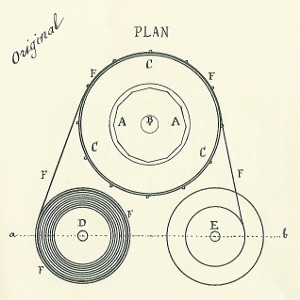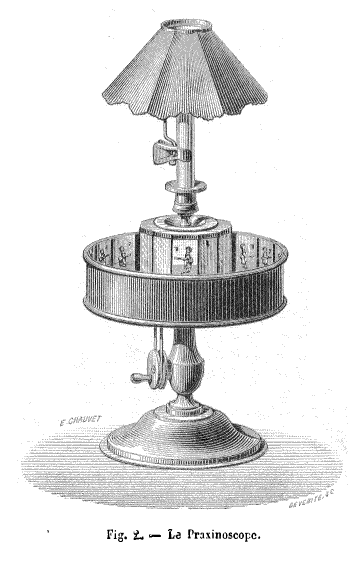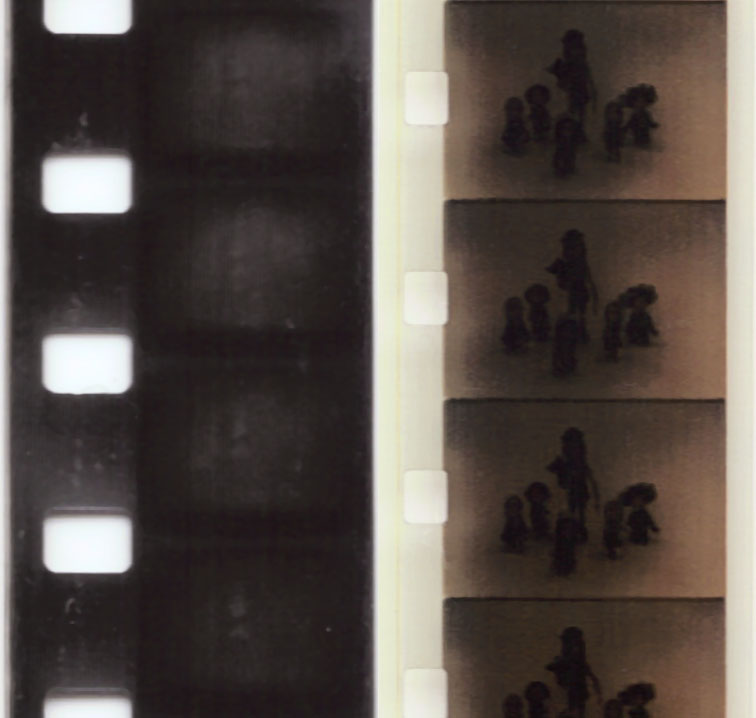|
Théâtre Optique
The Théâtre Optique (Optical Theatre) is an animated moving picture system invented by Émile Reynaud and patented in 1888. From 28 October 1892 to March 1900 Reynaud gave over 12,800 shows to a total of over 500,000 visitors at the Musée Grévin in Paris. His ''Pantomimes Lumineuses'' series of animated films include ''Pauvre Pierrot'' and ''Autour d'une cabine''. Reynaud's Théâtre Optique predated Auguste and Louis Lumière's first commercial, public screening of the cinematograph on 28 December 1895, which has long been seen as the birth of film. Technology The realized films had 300 to 700 transparent pictures of successive phases of moving figures with black backgrounds. The pictures were hand painted by Reynaud in aniline inks directly on 6 x 6 cm gelatin plates. The plates were coated with shellac and framed in a cardboard strip of which the sides were clad in fabric bands attached with split pins. The horizontal film strip could be up to 50 meters long, with bl ... [...More Info...] [...Related Items...] OR: [Wikipedia] [Google] [Baidu] |
Praxinoscope
The praxinoscope was an animation device, the successor to the zoetrope. It was invented in France in 1877 by Charles-Émile Reynaud. Like the zoetrope, it used a strip of pictures placed around the inner surface of a spinning cylinder. The praxinoscope improved on the zoetrope by replacing its narrow viewing slits with an inner circle of mirrors, placed so that the reflections of the pictures appeared more or less stationary in position as the wheel turned. Someone looking in the mirrors would therefore see a rapid succession of images producing the illusion of motion, with a brighter and less distorted picture than the zoetrope offered. Variations Reynaud introduced the Praxinoscope-Théâtre in 1879. This was basically the same device, but it was hidden inside a box to show only the moving figures within added theatrical scenery. When the set was assembled inside the unfolded box, the viewer looked through a rectangular slot in the front, onto a plate with a transparent m ... [...More Info...] [...Related Items...] OR: [Wikipedia] [Google] [Baidu] |
Thomas Edison
Thomas Alva Edison (February 11, 1847October 18, 1931) was an American inventor and businessman. He developed many devices in fields such as electric power generation, mass communication, sound recording, and motion pictures. These inventions, which include the phonograph, the motion picture camera, and early versions of the electric light bulb, have had a widespread impact on the modern industrialized world. He was one of the first inventors to apply the principles of organized science and teamwork to the process of invention, working with many researchers and employees. He established the first industrial research laboratory. Edison was raised in the American Midwest. Early in his career he worked as a telegraph operator, which inspired some of his earliest inventions. In 1876, he established his first laboratory facility in Menlo Park, New Jersey, where many of his early inventions were developed. He later established a botanical laboratory in Fort Myers, Flor ... [...More Info...] [...Related Items...] OR: [Wikipedia] [Google] [Baidu] |
Film Perforations
Film perforations, also known as perfs and sprocket holes, are the holes placed in the film stock during manufacturing and used for transporting (by sprockets and claws) and steadying (by pin registration) the film. Films may have different types of perforations depending on film gauge, film format, and intended usage. Perforations are also used as a standard measuring reference within certain camera systems to refer to the size of the frame. Some formats are referred to in terms of the ratio "perforations per frame/gauge size" to provide an easy way of denoting size. For instance, 35mm Academy is also known as 4 perf-35mm; VistaVision is 8 perf-35mm; the long-time standard Todd-AO 70 mm film is 5 perf-70mm; and IMAX is 15 perf-70mm. This description does not indicate whether the film transport is horizontal or vertical, but uncertainty is precluded because there are currently no horizontal systems using the same number of perforations on the same gauge as a vertical on ... [...More Info...] [...Related Items...] OR: [Wikipedia] [Google] [Baidu] |
UNESCO
The United Nations Educational, Scientific and Cultural Organization is a specialized agency of the United Nations (UN) aimed at promoting world peace and security through international cooperation in education, arts, sciences and culture. It has 193 member states and 12 associate members, as well as partners in the non-governmental, intergovernmental and private sector. Headquartered at the World Heritage Centre in Paris, France, UNESCO has 53 regional field offices and 199 national commissions that facilitate its global mandate. UNESCO was founded in 1945 as the successor to the League of Nations's International Committee on Intellectual Cooperation.English summary). Its constitution establishes the agency's goals, governing structure, and operating framework. UNESCO's founding mission, which was shaped by the Second World War, is to advance peace, sustainable development and human rights by facilitating collaboration and dialogue among nations. It pursues this objec ... [...More Info...] [...Related Items...] OR: [Wikipedia] [Google] [Baidu] |
Conservatoire National Des Arts Et Métiers
A music school is an educational institution specialized in the study, training, and research of music. Such an institution can also be known as a school of music, music academy, music faculty, college of music, music department (of a larger institution), conservatory, conservatorium or conservatoire ( , ). Instruction consists of training in the performance of musical instruments, singing, musical composition, conducting, musicianship, as well as academic and research fields such as musicology, music history and music theory. Music instruction can be provided within the compulsory general education system, or within specialized children's music schools such as the Purcell School. Elementary-school children can access music instruction also in after-school institutions such as music academies or music schools. In Venezuela El Sistema of youth orchestras provides free after-school instrumental instruction through music schools called ''núcleos''. The term "music school" ... [...More Info...] [...Related Items...] OR: [Wikipedia] [Google] [Baidu] |
Léon Gaumont
Léon Ernest Gaumont (; 10 May 1864 – 10 August 1946) was a French inventor, engineer, and industrialist who was a pioneer of the motion picture industry. He founded the world’s first and oldest film studio Gaumont Film Company, and worked in partnership with Solax Studios. Biography Léon Ernest Gaumont, born in Paris was gifted with a mechanical mind which led him to employment manufacturing precision instruments. From early childhood, he was fascinated by the technique of photography. When he was offered a job at the Comptoir géneral de photographie in 1893, he jumped at the opportunity. His decision proved fortunate when two years later he was given the chance to acquire the business. In August 1895, he partnered with the astronomer Joseph Vallot, the famous engineer Gustave Eiffel, and the financier Alfred Besnier to make the purchase. Their business entity, called L. Gaumont et Cie, has survived in one form or another to become the world's oldest surviving film com ... [...More Info...] [...Related Items...] OR: [Wikipedia] [Google] [Baidu] |
Le Clown Et Ses Chiens
''Le Clown et ses chiens'' (aka ''The Clown and His Dogs'') is an 1892 French short animated film hand-painted in colour by Émile Reynaud. It consists of 300 individually painted images and lasts about 10 minutes. It was the second film that Reynaud made for his Théâtre Optique, after '' Un bon bock'' (created in 1888). The film shows a clown entering a circus ring and greeting the audience, before he starts to perform tricks with three dogs. The dogs jump through hoops, walk on a ball and jump over a wand. It premiered theatrically alongside '' Pauvre Pierrot'' and '' Un bon bock'' on 28 October 1892 as part of Reynaud's ''Pantomimes Lumineuses'' program at the Musée Grévin and lasted until February 1894. Reynaud gave the whole presentation himself manipulating the images, accompanied by Gaston Paulin on the piano. With the exception of ''Un bon bock'', and Théâtre Optique films after this one, no footage can be found due to Reynaud throwing all of his films (except for ... [...More Info...] [...Related Items...] OR: [Wikipedia] [Google] [Baidu] |
Un Bon Bock
''Un bon bock'' (aka ''A Good Beer'') is an 1892 French short animated film directed by Émile Reynaud. Painted in 1888, it was first screened on 28 October 1892 using the Théâtre Optique process, which allowed him to project a hand-painted colored film, before the invention of cinematograph. About the film It consisted of 700 individually painted 6 x 6 cm pictures in a 50 meter long flexible strip. Reynaud manipulated the speed and repeated movements by moving the film back and forth through the projector to tell a visual story that lasted close to fifteen minutes. It is one of the first animated films ever made and was the first to be screened on Reynaud's modified praxinoscope, the Théâtre Optique, translated as "optical theatre". Alongside ''Le Clown et ses chiens'' - painted in 1890 - and '' Pauvre Pierrot'' - painted in 1891 - it was exhibited on 28 October 1892 when Émile Reynaud opened his Cabinet fantastique at the Musée Grévin. The program was billed as ... [...More Info...] [...Related Items...] OR: [Wikipedia] [Google] [Baidu] |
La Nature
''La Nature'' (English: ''Nature'') was a French language magazine aimed at the popularization of science established in 1873 by French scientist and adventurer Gaston Tissandier. The magazine also received an enormous amount of time, effort, and contributions from his brother, Albert Tissandier. Evolution The beginning From 1873 to 1914, each year's volume started at the beginning of December. The second six-month period began with the first issue in June. Starting in 1915, ''La Natures publishing year was brought in sync with the calendar year. A weekly magazine until the 1920s, it became first fortnightly and then monthly in 1948. Second World War During the Second World War, ''La Nature'' was published only erratically. The first interruption in publishing lasted from September 15 to December 15, 1939, with only an additional six issues published during all of 1940. 1941 saw 12 issues published, on the 15th of each month. There were other suspensions in publication, ... [...More Info...] [...Related Items...] OR: [Wikipedia] [Google] [Baidu] |
Paris
Paris () is the capital and most populous city of France, with an estimated population of 2,165,423 residents in 2019 in an area of more than 105 km² (41 sq mi), making it the 30th most densely populated city in the world in 2020. Since the 17th century, Paris has been one of the world's major centres of finance, diplomacy, commerce, fashion, gastronomy, and science. For its leading role in the arts and sciences, as well as its very early system of street lighting, in the 19th century it became known as "the City of Light". Like London, prior to the Second World War, it was also sometimes called the capital of the world. The City of Paris is the centre of the Île-de-France region, or Paris Region, with an estimated population of 12,262,544 in 2019, or about 19% of the population of France, making the region France's primate city. The Paris Region had a GDP of €739 billion ($743 billion) in 2019, which is the highest in Europe. According to the Economis ... [...More Info...] [...Related Items...] OR: [Wikipedia] [Google] [Baidu] |







